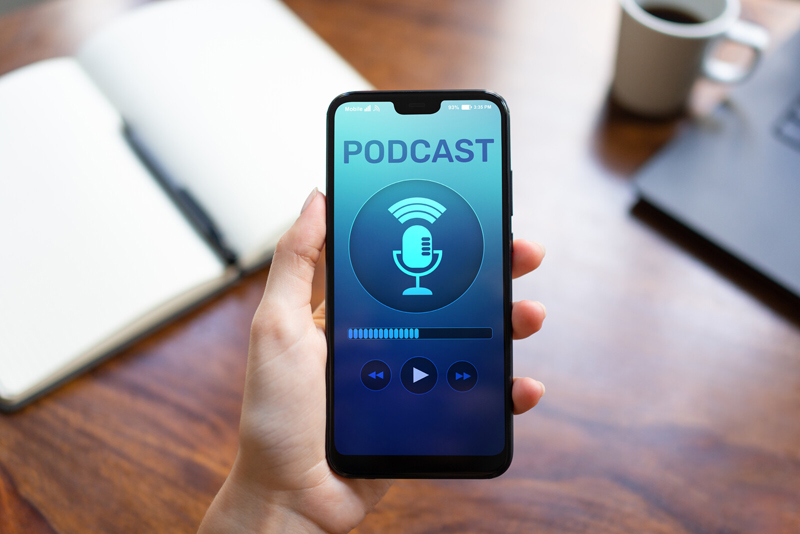Podcasts are a popular media platform, attracting a highly engaged and continually expanding audience. Ranging from 30 minutes to an hour in length and covering just about anything, podcasts are easily accessible and available to suit the listener’s convenience. All of this makes them a powerful way to reach audiences. Transcribing your podcast episodes is a great marketing strategy. Podcast transcription ensures the written content is indexed by search engines, boosting its online visibility.
Here are some statistics from the 2024 Edison Research Podcast Consumer Survey which show why this media platform is an ideal advertising tool:
- In 2024, of the 12+ population, 67% has listened to a podcast, 47% are monthly podcast listeners and 34% are weekly listeners.
- Podcasts now account for 11% of the daily time spent listening to all audio by those age 13.
- Podcasts reach all age groups — monthly podcast listeners comprise: 29% of kids age 6-12, 59% of people age 12-34, 55% of those age 35-54, and 27% of those age 55+.
- 46% of weekly podcast listeners have purchased a product or service as a result of hearing an ad on a podcast.
Factors driving the Popularity of Podcasts
- Engaging format: Podcasts are an easy and digestible media form, and people can multitask while listening to them. They can listen to them when they are preparing a meal, driving or walking, running or riding a bike. In fact, this is what makes podcasts appealing to fast-paced millennials who listen in through their smartphones, tablets, or other mobile devices.
- The intimacy factor: Consistently published podcasts with good content connects with listeners and builds trust. When someone listens to your podcast, you can connect with them directly and tell your story. Podcasts have a narrowly focused topic and make deeper connections with niche interests. People can easily access and listen to podcasts within a short time after they are published. Most people listen alone, making each listener feel more connected with the host.
- Content to suit listeners’ specific needs: There are podcasts available on almost every topic. They come in various formats such as interviews, conversations, educational sessions, solo-casts, and fiction and non-fiction storytelling. Consumers can choose the content they prefer and avoid excessive information overload with short podcasts. Whether its politics, science, or fiction, people can find podcasts that fit their requirements.
- Podcast listening apps: Podcast listening platforms or apps allow people to find, subscribe to, and listen to their favorite podcasts. Apps present consumers with a list of podcasts that they can choose to subscribe to. By subscribing to a show, they can maintain a list of their favorite podcasts and get notified about new episodes. Popular podcast apps include Podcast Casts, Spotify, Podbean, Apple Podcasts, and Castbox. In addition to the ability to play, pause, subscribe, and add to a playlist, apps come with variable speed.
- Informative: Podcast creators/hosts are generally experts on their topic and interested in sharing as much information as possible with their audience. Podcasts offer in-depth information about a topic that wouldn’t be available in a radio or TV program, news story, or blog.
How to Make the Most of Podcasts for Marketing
With podcast growth exploding in the United States, this digital media format has become a compelling and cost-effective advertising option for businesses. They do not require a heavy investment and initial episodes can be recorded on a smartphone or tablet.
Here are 8 ways to leverage the power of podcasts for content marketing:
- Have a clear objective: Clearly define the purpose of your podcast. Are you looking to increase your authority, grow your business, or expand your audience? Understanding your primary objective will help you develop the right content and strategy.
- Ensure consistency: Consistently publishing new episodes is crucial for attracting and retaining your target audience. Create a content calendar and stick to a regular publishing schedule to maintain momentum and keep your listeners engaged.
- Establish a social media presence: Create social media profiles using the name of your show. Rather than creating accounts on multiple platforms, consider social media channels your target audience uses most and focus your efforts there. Social media can be a powerful marketing tool, but only if you actively engage with your followers. By maintaining an active presence on the right social media platforms, you can connect with your audience, share your content, and encourage listeners to subscribe, rate, and review your podcast.
- Stay focused: Successful podcasts have a narrow, focused topic. Identify your audience’s problems, interests, and concerns, and tailor your content to address them. This will help you build a loyal following and establish yourself as an expert in your niche.
- Craft a compelling introduction: Your podcast introduction should include a brief personal introduction, an overview of what listeners can expect, and a preview of upcoming episodes. Remember to encourage listeners to like, comment, share, or subscribe to your podcast.
- Invest in quality equipment: Using the right equipment can significantly improve the production quality of your podcast. Essential items include a computer, microphone, audio interface, mixer, pop filter, headphones, and recording/editing software. Investing in quality gear will enhance the listening experience for your audience.
- Set up an account with a podcast platform: While this is optional, digital marketing experts recommend submitting podcasts to major directories to make it more discoverable. Podcast apps make it easy for listeners to find and subscribe to your content listed on these popular platforms. Most platforms require a valid RSS feed to verify your podcast’s legitimacy and ownership, so ensure you have one set up beforehand. Top podcast directories worth submitting to include Apple Podcasts, Spotify, Stitcher, and Audible.
- Cross-promote on other podcasts: Collaborating with other podcasters can be an effective way to reach new audiences. One method is an “ad swap” where you run an ad for their show on your podcast, and they do the same for you. Another approach is “content collaboration”, such as interviewing each other on your respective shows. This exposes your audience to the other podcaster, and vice versa, giving listeners a chance to get to know you both. If they enjoy the cross-over content, they may be more inclined to subscribe to your podcast.
The Value of Podcast Transcription
Transcribing your podcast episodes is a great marketing strategy. For example, “This American Life” is a popular podcast series that leverages transcription to making its podcast accessible to its 2 million weekly listeners. Each episode on its website includes a transcript.
Companies providing digital transcription services can convert your audio recordings into clear text documents. Transcripts offer several key benefits:
- Improved SEO: Transcripts give Google written content to index, helping your episodes rank higher in searches.
- Accessibility: Transcripts make your podcast accessible to those with hearing impairments.
- Audience Conversion: Transcripts allow potential listeners to quickly scan for relevant content, increasing the chances they’ll tune in.
In short, taking the time to transcribe your podcast episodes can significantly expand your audience and listenership.
Transcribe your podcast episodes with our professional digital transcription services!





